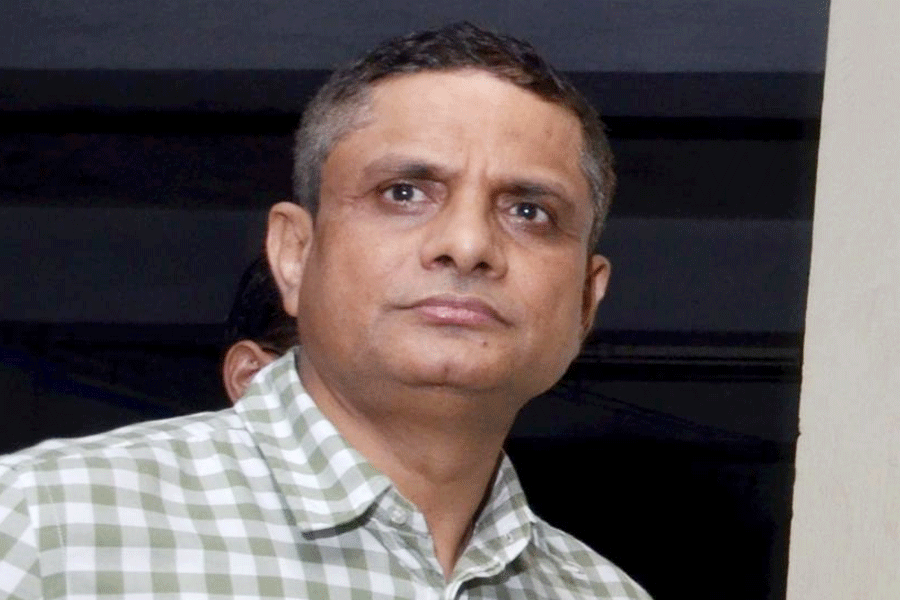
On board the USS Carl Vinson: The morning after the night Gepetto bombed a suspected Islamic State facility in Iraq, he was saying in the aircrew room of this carrier that "typically, when I launch I do not have a target".
The 29-year-old lieutenant, who can be identified only by his call sign, is a pilot with the Fighting Redcocks squadron of F/A 18F Super Hornet and F/A 18C Hornet fighter jets.
The bomb his flight dropped was a 500-pound Laser Guided Joint Direct Attack Munition (LJDAM) that he says can be glided to the target. Gepetto does not know what the target was. The LJDAM is the weapon of choice in the airstrikes against the Islamic State that began nine months ago in August 2014.
Gepetto was given the coordinates of the target by a joint tactical area command when he was loitering in the night skies, presumably over northern Iraq. He had launched from the USS Carl Vinson, the aircraft carrier, for a mission that was to last six hours during which he would refuel in mid-air four times.

The target is suspected to have been a facility of the Islamic State (IS), earlier known as the Islamic State of Iraq and the Levant (ISIL). Given the current orientation of the war against the Islamic State, it is likely the target was in or around the northern Iraqi city of Mosul that the militants have overrun.
Gepetto is at one end of a spectrum of war that the US says is engulfing nations from within and without: from France, where the satirical cartoon magazine Charlie Hebdo was attacked, to India, where a 24-year-old Bengali techie from North 24-Parganas working in Bangalore, Mehdi Masroor Biswas, is alleged to have been fronting an IS propaganda and recruitment node on the Internet.
In the arc of fire from Kaikhali, the North 24-Parganas town to which Biswas belonged, to Kobane on the Syria-Turkey border where the Peshmerga (Kurdish fighters) are eyeball-to-eyeball with the IS, the random flames singe governments and peoples in unknown ways.
Here, in the "bathtub" called the Persian Gulf, sails one of the most potent military platforms in the world, using some of the most devastating firepower humankind has produced.
The Vinson sails in waters it cannot trust, bounded as they are by Iran on one side and sundry non-state actors like Somali pirates capable of mining the seas with lone-wolf bombs on the other.
In the quiet wardroom of the Vinson where there is catfish-in-white sauce on offer for lunch and delicious ice cream for dessert, the war thumps on the flight deck above where aircraft are "arrested" and "launched" with unfailing regularity.

The planes are forced into a landing with "arrester wires", with hooks hanging out of their tails that have to catch one of four cables taut across the deck. They are "launched" with catshots - steam catapults powered by the two nuclear reactors that propel the 95,000-tonne carrier.
In the night, the afterburners of the fighter jets carve streaks of flame above the dark green waters of the Persian Gulf, cutting across the reflected moonbeams.
On Wednesday, the hangar bay in the belly of the Vinson was crowded with its sailors in colour-coded shirts - red for ordnance, green for maintenance - as the supply ship USNS Rainier pulled up alongside and transferred biscuits, cakes, cheese, cereal, Triscuits, meat - and bombs - during a weekly replenishment-at-sea.
"We are taking in 1.3 million gallons of gas today," said an officer. The Vinson has a crew of 5,300. Each day it must have 15,000 meals ready, including midnight snacks.
It was from the hangar bay of this ship that the body of Osama bin Laden, killed in Pakistan's Abbotabad by US Navy Seals, was given a burial-at-sea in May 2011. The event was confirmed to the Pentagon by a message from the ship: "FedEx delivered the package."
The effect of landing and taking off from the carrier takes a toll on the human body that has to be able to take pressure up to four to five times the force of gravity. The arrested landing and a catshot marked the beginning and end of a day and a half spent on board the Vinson by this correspondent of The Telegraph during a US government-sponsored reporting tour.
The US Pacific commander who was visiting New Delhi at the time of the tour has offered to send the Vinson to Indian waters for the next edition of the Malabar series of exercises with the Indian Navy, due in three to four months. The Vinson is too large to be able to berth in any of the Indian ports. On its return from its deployment to the Gulf, the vessel is likely to be at anchorage for the drills with the Indian Navy.
It won't be the first time. In 2007, the Indian Navy engaged with two US carriers, the USS Nimitz and the USS Kitty Hawk, and with the navies of four other countries in the Bay of Bengal.
"My dad was in Bombay and went to school in Kodaikanal (Tamil Nadu) though I've never been to India myself," says Capt. Karl Thomas, commanding officer of the carrier, establishing a connect before getting into business.
"This isn't just a US war - a lot of countries realise that the (Islamic State) Caliphate concept is really a seventh-century way of thinking," he says. The beheadings of journalists and aid workers have provoked the US into getting into the war from a distance just as it was winding down from Iraq and Afghanistan.
Most of all, for the aircrew and the sailors on board the Vinson, the image of a Jordanian pilot being burnt by the IS is a motivator against a medieval practice.
On December 24, a Royal Jordanian Air Force pilot, Lt Moath al-Kasasbeh, flying a US-made F-16 jet, went down in the Euphrates river.
The Jordan Times newspaper reported that al-Kasasbeh was fished out of the water by IS volunteers who demanded the release of one of their comrades from Jordan. On February 3, the IS released videos of al-Kasasbeh being burnt in a cage and then being buried under mounds of debris. They justified the act by claiming that the US was subjecting Muslims to such a fate - by burning and burying them under debris - through the airstrikes.
The Vinson generates about a third of the airstrikes on IS targets, the balance being conducted by land-based aircraft of the US and its coalition partners. The Vinson generates close to 90 sorties a day in a 24-hour cycle.
The F/A 18 Super Hornet fighter jets launched from the Vinson are capable of carrying up to 16,000 pounds of ordnance each, chief among which are the 500-pound LJDAMs. Not all the aircraft launched are fighter jets - there are also the E2C Hawkeye, the aircraft with "radomes" on top that function as Airborne Early Warning and Control platforms that suss out ground (and aerial, if any) targets by using powerful sensors and relay them to the combat aircraft.
Despite the superpower technology that plays out in the Persian Gulf and in the "over-the-beach" operations, there is a nagging suspicion that the IS has dug itself in.
Back in Bahrain, where the US navy's central command component is located in its 5th Fleet headquarters, the deputy commander, Rear Adm. James T. Loblein, says: "When the Dayesh (the Arabic name for the IS) came into Iraq (from Syria) last year, it was like an army. And now they are looking more like a terrorist group."
On the Vinson, Capt. Thomas says: "The enemy has gotten smarter. They have hunkered down. They are building defences. They were in the offensive in the past. Now they are defensive. You can see many of our planes return without offloading their bombs. So we validate our targets. We've got smarter too."
The IS, in other words, is presenting less visible targets now than it was nine months ago. At the same time, the "coalition forces" have reinforced. Last week, the French aircraft carrier, the Charles de Gaulle, joined the Vinson in the Gulf. On Wednesday, two French Rafale aircraft - a version of which the Indian Air Force is negotiating for purchase - landed on the flight deck of the Vinson.
With the addition of the French carrier, says Rear Adm. Christopher Grady, the commander of the Vinson Strike Group, an additional 15 to 20 per cent of sorties may be generated.
"The more you have the better it is because you have more chances to hit," he explains. "The enemy is adaptive and creative but we're more adaptive and creative."
The more the combat jets the more they are likely to find targets that are otherwise hidden by the IS.
Asked about the threat emphasised by the shooting down of the Jordanian pilot, Grady says: "We fly above the altitude of threat to our aircraft."
This means that any surface-to-air missiles that the IS may have in its arsenal - such as Stingers - will fall short of the height at which the US and French jets fly over Iraq and Syria. It also means that the combat pilots are dependent on technology, sensors that beep targets into screens and laser guidance that glide bombs towards them, than on physical sighting of the enemy.
That raises fears of civilian "collateral" damage. That fear prompts fighter pilot Gepetto to emphasise that the fighter sorties usually return with more than half their bombs unloaded.
In the weeks from now, the US is expecting that ground forces in Iraq will be mobilised enough to mount an attack to rid Mosul of the IS with the close air support given by the jets from the Vinson and the Charles de Gaulle.
Mosul, where the IS demolished 3,000-year-old monuments last fortnight and a wealth of historical evidence of how human civilisation was born and nurtured, is northern Iraq's most important city.
From around Mosul, 39 Indians who were mostly labourers from Punjab have been missing for months, presumed to have been kidnapped by the IS. There is no confirmation of their fate, no evidence of whether they are dead or alive.
Hostage to a war of superpower technology and medieval ideology, their silence is lost in the rustle of ripening corn from the banks of the Euphrates to the fields by the Beas, singed by wanton flames from an arc of fire.










